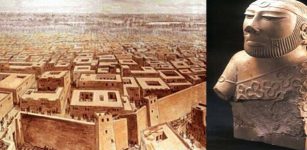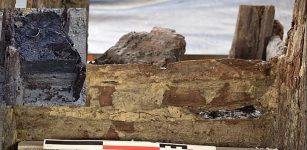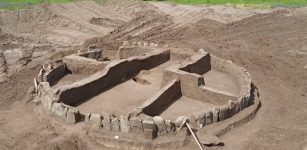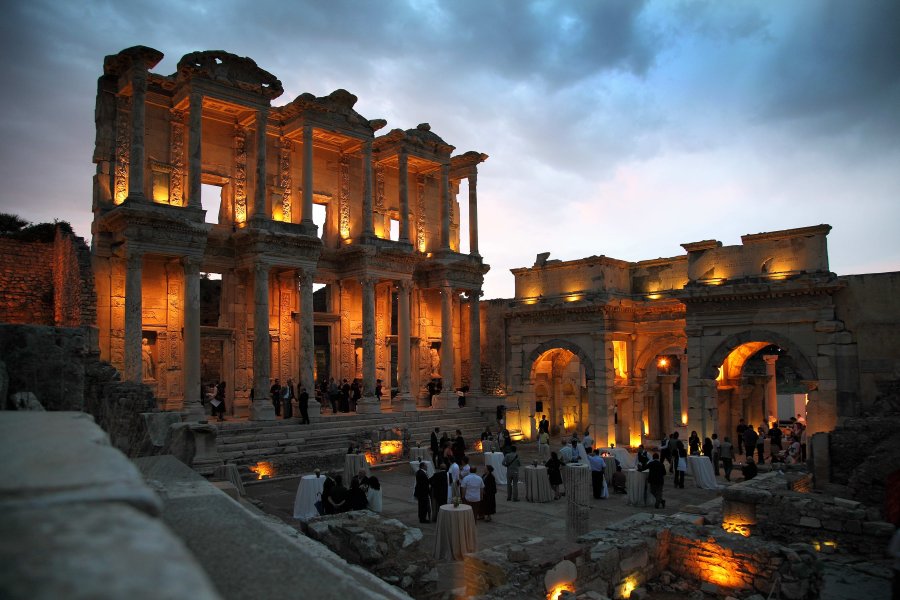Library Of Celsus: Beautiful Classic Monument In Ephesus That Stored 12,000 Scrolls
A. Sutherland - AncientPages.com - The library of Celsus is one of the best known and the most beautiful classic monuments in Turkey.
It was built in 117 AD to serve as a monumental mausoleum for Gaius Julius Celsus Polemaeanus, the governor of the province of Asia from his son Galius Julius Aquila. Celsus was born in Sardeis, once the capital of the ancient kingdom of Lydia.
"...the narrow crypt under the apse contains even today the sarcophagus with the earthly remains of the donator (Fig. 5). The sarcophagus, chiselled out of a marble block, is 2.68 m long, 1.10 m wide and 1.75 m high, and decorated with garlands carried by Eros's and Nikes..."(V. M Strocka) Image credit: V. M Strocka
His father was a Roman knight and Celsus read the law and began his military career 68 AD as military tribune in Alexandria, in the legion that was to proclaim its commander Titus Flavius Vespasianus, emperor.
Celsus is buried in a crypt beneath the library in a richly decorated marble sarcophagus. The structure's marble facade located on a nine-stepped podium rises to 17 m in height. The library's marble gate located on the north side, was reconstructed by the donators Mazaios and Mithridates from the time of Caesar Augustus (4 or 3 BC and was dedicated to the emperor Augustus, served as the monumental entrance to Ephesus' Commercial Agora.
The Library of Celsus, which stored 12,000 scrolls, was the third-largest library in the ancient world behind both Alexandria and Pergamum.
Facade of the Library of Celsus at night. Image credit: Austrian Archaeological Institute via wikipedia
In the donation inscription of the Celsus library, which was chiseled on the facade of the lower
floor over the farthest southern niche, there is written (as cited by Volker M. Strocka, a German classical archaeologist who since 1967 he regularly took part in the Austrian research in Ephesus and was responsible for the reconstruction of the Celsus Library):
"To Tiberius lulius Celsus Ptolemaeanus, consul and proconsul of Asia. Tiberius lulius Aquila
Ptolemaeanus, consul, his son, built the Celsian library out of his own funds, with all the building
decorations, the statues and books.
"He also left 25.000 dinars for its equipment and for the acquisition of books, 2000 dinars of which were spent in one year, so that from the annual interest of the remaining 23.000 the library will be kept and its attendants will be paid 18001 dinars, which shall be paid to them on the birthday of Celsus for all times. And also according to the will of Aquila new books shall be bought every year. And also his [Celsus's] statues shall be hung with wreaths thrice a year. And also all other statues shall be decorated every year on the [birthday] feast of Celsus.
The Library of Celsus, Ephesus Turkey. Image credit: Low Cost Europe Travel
"After the same heirs had commissioned the equipment of the library with the 2000 dinars taken (from the capital], the library was officially Opened on the feast of Celsus (?), so that... on the seventeenth on the month... according to the wording of the will, no [demand nor] deduction nor expenditure shall be put up to them from the stated funds, for the heirs of Aquila have wholly completed the work. Executor of the will was Tiberius Claudius Aristion, three times asiarch...."
The library's nine steps leading to the entrance of the library consisted of three large doors. Large windows had been constructed above the doors and the second floor in order to let light enter the library. The scrolls of the manuscripts were kept in cupboards in niches on the walls. There were double walls behind the bookcases to prevent them from the extremes of temperature and humidity.
The building has niches decorated with statues, which today are copies of the originals. The figures symbolize wisdom (Sophia), knowledge (Episteme), intelligence (Ennoia) and valor (Arete). These are the virtues of Celsus.
The library was either destroyed by the earthquake of 262 AD, or the Goths plundered the city of Ephesus and shortly afterward had set fire to the library. Fortunately, a great part of its façade was not damaged seriously, so it has survived nowadays in a pretty good condition.
The library was restored with the aid of the Austrian Archaeological Institute and the originals of the statues were taken to Ephesus Museum in Vienna in 1910. However, about a hundred years ago, nothing was yet known of the library and its ruins were covered with the debris of the ruined city of Ephesus that was abandoned in the early middle ages. In 1903, the remains of the library's facade that had collapsed during an earthquake were identified by an archaeological expedition from Austria.
There was also an auditorium that was used for lectures or presentations between the library and the Marble Road. It was built during the reign of the Emperor Hadrian.
Written by – A. Sutherland - AncientPages.com Senior Staff Writer
Copyright © AncientPages.com All rights reserved. This material may not be published, broadcast, rewritten or redistributed in whole or part without the express written permission of AncientPages.com
More From Ancient Pages
-
 Remarkable Discovery – 22,000-Year-Old Drag-Marks In New Mexico Are The Earliest Evidence Of Transport Vehicles Ever Found!
Archaeology | Feb 24, 2025
Remarkable Discovery – 22,000-Year-Old Drag-Marks In New Mexico Are The Earliest Evidence Of Transport Vehicles Ever Found!
Archaeology | Feb 24, 2025 -
 Suprising Evolution Discovery – Human Temporal Lobes Are Not Very Large In Comparison With Other Primates
Archaeology | Mar 21, 2023
Suprising Evolution Discovery – Human Temporal Lobes Are Not Very Large In Comparison With Other Primates
Archaeology | Mar 21, 2023 -
 Controversial Ancient History Of Harappa And Mohenjo Daro – Advanced Indus Valley Civilization Pre-Dates Egypt’s Pharaohs And Mesopotamia
Civilizations | Apr 15, 2017
Controversial Ancient History Of Harappa And Mohenjo Daro – Advanced Indus Valley Civilization Pre-Dates Egypt’s Pharaohs And Mesopotamia
Civilizations | Apr 15, 2017 -
 Czech Neolithic Well Is Oldest Wooden Structure In The World
Archaeology | Mar 11, 2020
Czech Neolithic Well Is Oldest Wooden Structure In The World
Archaeology | Mar 11, 2020 -
 Daily Life Of A Lady In Waiting – A Dangerous Profession Sometimes
Ancient History Facts | Aug 24, 2023
Daily Life Of A Lady In Waiting – A Dangerous Profession Sometimes
Ancient History Facts | Aug 24, 2023 -
 Ancient Egyptian Blue Powder Makes Fingerprints Glow And Will Be Used By Crime Scene Investigators
Ancient Technology | Jun 15, 2017
Ancient Egyptian Blue Powder Makes Fingerprints Glow And Will Be Used By Crime Scene Investigators
Ancient Technology | Jun 15, 2017 -
 8-Million-Year-Old Jaw May Offer Evidence Humans Evolved In Europe Instead Of Africa – Controversial Theory Suggests
Archaeology | Apr 24, 2019
8-Million-Year-Old Jaw May Offer Evidence Humans Evolved In Europe Instead Of Africa – Controversial Theory Suggests
Archaeology | Apr 24, 2019 -
 Hades – Land Of The Dead In Greek Beliefs Offered Punishment And Paradise Full Of Harmony
Featured Stories | Aug 15, 2019
Hades – Land Of The Dead In Greek Beliefs Offered Punishment And Paradise Full Of Harmony
Featured Stories | Aug 15, 2019 -
 Secrets Of Namibia’s Fairy Circles Solved – Self-Organizing Plants Are The Creators – New Theory
Archaeology | Oct 21, 2022
Secrets Of Namibia’s Fairy Circles Solved – Self-Organizing Plants Are The Creators – New Theory
Archaeology | Oct 21, 2022 -
 Ancient Secrets Of The Ukrainian Stonehenge That Is Older Than The Giza Pyramids Of Egypt
Featured Stories | Jul 17, 2021
Ancient Secrets Of The Ukrainian Stonehenge That Is Older Than The Giza Pyramids Of Egypt
Featured Stories | Jul 17, 2021 -
 Medieval Sword Found In The Sea Off The Carmel Coast Was Probably Used In Combat 800 Years Ago
News | Aug 4, 2023
Medieval Sword Found In The Sea Off The Carmel Coast Was Probably Used In Combat 800 Years Ago
News | Aug 4, 2023 -
 The Parthenon Marbles Evoke Particularly Fierce Repatriation Debates – An Archaeologist Explains Why
Artifacts | Jul 1, 2024
The Parthenon Marbles Evoke Particularly Fierce Repatriation Debates – An Archaeologist Explains Why
Artifacts | Jul 1, 2024 -
 Ancient DNA Reveals Surprising Stories About Migrations And Genetic Mixing Of Our Ancestors
Archaeology | Feb 22, 2018
Ancient DNA Reveals Surprising Stories About Migrations And Genetic Mixing Of Our Ancestors
Archaeology | Feb 22, 2018 -
 Evidence Of An Advanced Ancient Civilization In Texas That Mysteriously Disappeared
Ancient Mysteries | Jul 18, 2024
Evidence Of An Advanced Ancient Civilization In Texas That Mysteriously Disappeared
Ancient Mysteries | Jul 18, 2024 -
 Have Archaeologists Found Evidence Of A Universal Ancient Civilization That Gave Birth To All Other Cultures Across The World?
Featured Stories | Mar 13, 2025
Have Archaeologists Found Evidence Of A Universal Ancient Civilization That Gave Birth To All Other Cultures Across The World?
Featured Stories | Mar 13, 2025 -
 Evidence Supporting Drumelzier Legend And Merlin’s Death In Scotland Uncovered By Archaeologists
Archaeology | Sep 4, 2024
Evidence Supporting Drumelzier Legend And Merlin’s Death In Scotland Uncovered By Archaeologists
Archaeology | Sep 4, 2024 -
 Raven Mocker And Cannibal Body Snatchers In Cherokee Mythology
Featured Stories | Jun 13, 2019
Raven Mocker And Cannibal Body Snatchers In Cherokee Mythology
Featured Stories | Jun 13, 2019 -
 Mysterious Death Of Amy Robsart – Murder, Accident Or Suicide?
Featured Stories | Jun 20, 2024
Mysterious Death Of Amy Robsart – Murder, Accident Or Suicide?
Featured Stories | Jun 20, 2024 -
 Mystery Of The Chinchorro Civilization And The World’s Oldest Mummies
Civilizations | Dec 27, 2016
Mystery Of The Chinchorro Civilization And The World’s Oldest Mummies
Civilizations | Dec 27, 2016 -
 Pompey The Great: One Of Roman Empire’s Most Successful Military Commanders
Featured Stories | Jun 14, 2019
Pompey The Great: One Of Roman Empire’s Most Successful Military Commanders
Featured Stories | Jun 14, 2019



